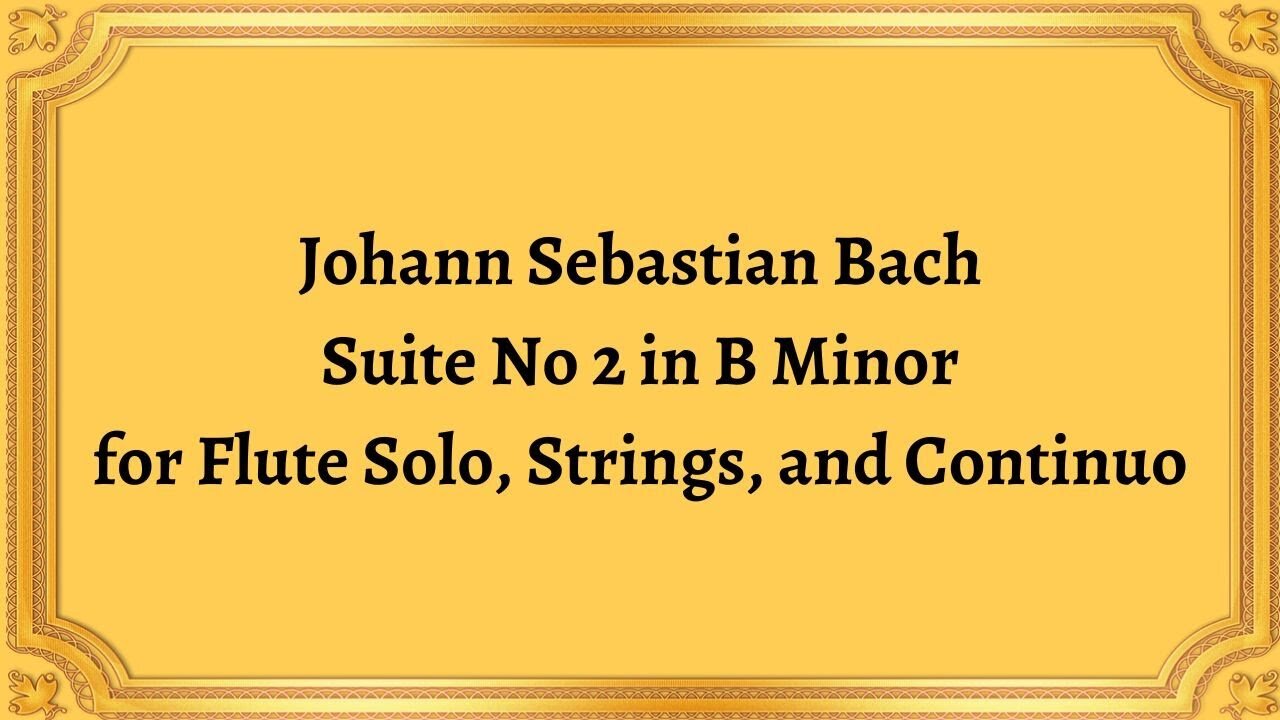Premium Only Content

Johann Sebastian Bach Suite No 2 in B Minor for Flute Solo, Strings, and Continuo
#JohannSebastianBach #SuiteNo2inBMinor #BaroqueMusic #Counterpoint #FluteSolo #Strings #Continuo #ChamberMusic #Ornamentation #Virtuosic
Johann Sebastian Bach Suite No.2 in B Minor for Flute Solo, Strings, and Continuo
Publication date 1950
THE STUTTGART CHAMBER ORCHESTRA conducted by KARL MUNCHINGER ANDRE PEPIN, Flute * DORIS ROSSIAUD, Harpsichord
Johann Sebastian Bach, one of the most celebrated composers of all time, is renowned for his mastery of counterpoint and extensive contributions to baroque music. The Suite No. 2 in B Minor for Flute Solo, Strings, and Continuo is a stunning example of Bach's exceptional musical talent.
The suite comprises seven movements, each with its unique style and character. The first movement, a fast and lively Prelude, establishes the piece's key and sets the tone for the rest of the Suite. The second movement is a gentle and serene Rondeau characterized by its dance-like melody and flowing counterpoint.
The third movement is a courtly Sarabande, known for its slow and dignified tempo and somber mood. It is followed by a lively and virtuosic Bourrée I and Bourrée II. Both movements feature fast tempos and intricate counterpoint that challenge the technical abilities of the performer.
The final two movements, a Polonaise and a Minuet, are elegant dance pieces characterized by their playful and jovial nature. Bach's exceptional compositional style is on full display in both movements, with intricate interplay between the flute, strings, and continuo.
The Suite No. 2 in B Minor is a significant example of Bach's musical style. It is a masterpiece of counterpoint, featuring complex melodic lines, intricate harmonies, and skillful contrapuntal techniques. The piece plays a significant role in the development of baroque music and has been a staple of the flute repertoire for centuries.
The complexity and sophistication of the Suite No. 2 in B Minor make it a challenging piece for performers. The technical demands on the flutist and string players require exceptional skill and musicianship. The flute part, in particular, requires excellent breath control, finger dexterity, and an understanding of Baroque ornamentation.
In conclusion, Johann Sebastian Bach's Suite No. 2 in B Minor for Flute Solo, Strings, and Continuo is a milestone in the history of baroque music. The composition exemplifies the composer's mastery of counterpoint and is a testament to his exceptional musical talent. The Suite's complex and sophisticated melodies, intricate harmonies, and challenging technical demands make it a significant piece in both the flute repertoire and baroque music as a whole.
You have the opportunity to support the channel https://destream.net/live/RadSiarAl/donate
-
 LIVE
LIVE
INFILTRATION85
35 minutes agoHi, I'm INFILTRATION
415 watching -
 LIVE
LIVE
GuardianRUBY
2 hours agoRumble Takeover! The Rumblings are strong
647 watching -
 LIVE
LIVE
Etheraeon
9 hours agoWorld of Warcraft: Classic | Fresh Level 1 Druid | 500 Follower Goal
397 watching -
 LIVE
LIVE
VapinGamers
1 hour ago🎮🔥Scrollin’ and Trollin’: ESO Adventures Unleashed!
342 watching -
 LIVE
LIVE
a12cat34dog
2 hours agoGETTING AFTERMATH COMPLETED :: Call of Duty: Black Ops 6 :: ZOMBIES CAMO GRIND w/Bubba {18+}
242 watching -
 LIVE
LIVE
NubesALot
5 hours ago $0.02 earnedDark Souls Remastered and party games
186 watching -
 LIVE
LIVE
GamersErr0r
16 hours agoOverwatch 2
251 watching -
 LIVE
LIVE
Phyxicx
3 hours agoRocket League with Friends! - 11/22/2024
109 watching -
 LIVE
LIVE
STARM1X16
3 hours agoFriday Night Fortnite
104 watching -
 29:51
29:51
Afshin Rattansi's Going Underground
18 hours agoJimmy Dore on Ukraine & WW3: Biden Wants a War that Trump CAN’T Stop, ONLY Hope is Putin’s Restraint
56.7K17